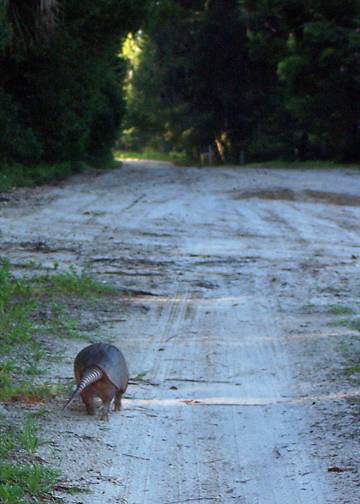Margot, this is one of my favorite “neighbor” photos. The photo was taken with a p/s, so the quality isn’t very good. This is NOT my favorite neighbor! I love the morning light coming through the trees at the curve in the road. I also love the fact that this particular neighbor is on his way to pester someone else.



Double wow! A lone armadillo starting out on a beautiful pestery morning. I don’t really know much about these prehistoric looking creatures – why are they pests? Do they root for bugs in your lawn? They look like they are diggers. Thanks for sharing yet another of your unique neighbors.
Margot, rooting for bugs would be putting it mildly. It is more like digging trenches! One little armadillo can destroy a lawn in one evening. They also make leg-breaking holes/caves to take a nap.
Are they aggressive? Have your dogs met any up close and personal? Do they travel in pairs? I suppose I could look it up on google, but I would love to hear what you know about them.
The photo is amazing – like get out of town before dawn!
Armadillos are not aggressive. I’m not even certain what they have in the way of teeth—have never looked in there. Their primary diet is bugs, such as grubs. They will dig a giant trench to find one grub!
If someone (don’t ask me how I know this)attempts to catch an armadillo, it will either burrow into the ground or run like hell. Don’t ask me how I know this either—but an armadillo can almost jump as high as a jack-rabbit while running!
JRT met an armadillo up close and personal and it rolled itself into a ball. Nothing gets through that armor.
Armadillos are supposed to be nocturnal, but we have seen them out during overcast days and early morning. Usually alone, but I also have photos of a pair.
Armadillos carry leprosy. How’s that for a neighbor. Just makes you want one for a pet to cuddle.
Years ago at FSU, Peter and I lived at one time in Jefferson Co. FL (I needed space). One night an armadillo tore through our land lady’s rose garden. Next night…her friend drove the pick-up with Betty wielding her shotgun out the window to kill (more like, blow to smithereens) the armadillo in question. We laughed our butts off, though it really did ruin her rose garden. Our cat Orbit also was allowed to get up close and personal to one without it acting out. I guess there must be friendly armadillos. They do make a mess of things though. Carole, got shotgun? 😉 Julie H
Wow, leprosy?? Interesting creatures. I will now have to google them … wonder how many there are, breeding cycles, life span, etc. I do think, however, I’m glad they do not reside in Washington/Oregon!
Julie H., you have the funniest stories!
Judy, if an Armadillo came to town,the only thing you would google would be how to get rid of one!
Armadillo Profile … (Interesting! I still have to look up the repro part.)
Of the 20 varieties of armadillo, all but one live in Latin America. The familiar nine-banded armadillo is the only species that includes the United States in its range.
Armadillo is a Spanish word meaning “little armored one” and refers to the bony plates that cover the back, head, legs, and tail of most of these odd looking creatures. Armadillos are the only living mammals that wear such shells.
Closely related to anteaters and sloths, armadillos generally have a pointy or shovel-shaped snout and small eyes. They vary widely in size and color, from the 6-inch-long (15-centimeter-long), salmon-colored pink fairy armadillo to the 5-foot-long (1.5-meter-long), dark-brown giant armadillos. Others have black, red, gray, or yellowish coloring.
Contrary to popular belief, not all armadillos are able to encase themselves in their shells. In fact, only the three-banded armadillo can, curling its head and back feet and contorting its shell into a hard ball that confounds would-be predators.
Armadillos live in temperate and warm habitats, including rain forests, grasslands, and semi-deserts. Because of their low metabolic rate and lack of fat stores, cold is their enemy, and spates of intemperate weather can wipe out whole populations.
Most species dig burrows and sleep prolifically, up to 16 hours per day, foraging in the early morning and evening for beetles, ants, termites, and other insects. They have very poor eyesight, and utilize their keen sense of smell to hunt. Strong legs and huge front claws are used for digging, and long, sticky tongues for extracting ants and termites from their tunnels. In addition to bugs, armadillos eat small vertebrates, plants, and some fruit, as well as the occasional carrion meal.
Population numbers of nearly all species are threatened by habitat loss and over-hunting. Many cultures in the Americas consume armadillo flesh, which is said to resemble pork in its flavor and texture. Currently, only the nine-band population is expanding, and some species, including the pink fairy, are threatened.
Good grief, JUDY!! You need a GSD!
Julie – are you reading this?! Truer words were never spoken :~)